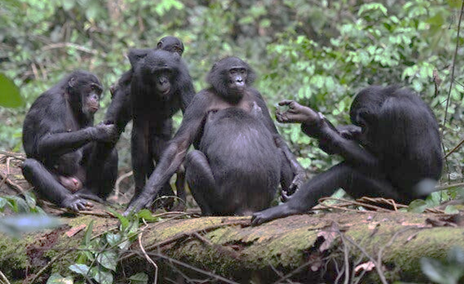science Watch / Saul Scheinbach
Females Rule Here
“Male dominance is not evolutionarily inevitable.” – M. Surbeck
Surbeck/Kokolopuri Bonobo Research Project
You may know that we have not just one, but two close primate relatives. We are familiar with the well-studied chimpanzee (Pan troglodytes) who shares about 99% of our DNA. We know they have a patriarchal society—males rule—and they are aggressive. Fights among males for dominance can become lethal. They also behave aggressively toward females to intimidate them to mate. They make war on neighboring troops to gain territory and in the process may kill a combatant and even cannibalize it.
Our other less well-known cousins, bonobos (Pan paniscusis), behave quite differently. They are relatively peaceful and live in a matriarchal society, rare among mammals. Neighboring troops do not fight. Instead, they share food and groom each other when they meet. And while males within a troop may fight with each other for dominance, mortality is rare. Indeed, like many married couples, arguments often end in some form of sex. The sex is usually brief. It can range from genital rubbing to copulation and may be heterosexual or homosexual. Given their peaceful nature and liberal use of sex, they are known as the hippies of the primate world who “make love, not war.”
Bonobos look like smaller, gracile and darker chimpanzees and are found only in a small, remote region of the Democratic Republic of Congo. That, along with their timidity and small numbers, has contributed to our relative ignorance of them. Now a study in the April 14, 2025, issue of Communications Biology has added to our understanding of bonobo society. A team of scientists led by Dr. Martin Surbeck, a behavioral ecologist at Harvard University, compiled troves of data on the behavior of six wild bonobo troops, some of which they have observed for up to 30 years.
The team spent thousands of manhours trekking through thick forests. “You get up around three o’clock in the morning, then walk for an hour or two to find the site where they built their nests the previous night,” said Surbeck. “And then you follow the group for the whole day till they make their nests again.” Their observations show that even though males are larger than females, the females keep the peace by suppressing male bellicosity. They do it by forming a coalition of females who punish males for aggressive behaviors.
The team considered three hypotheses to explain how females retain their rule over males. For example, when males outnumber females, constant aggression among males can push the losers’ social status below that of most females. Or females can mate preferentially with non-aggressive males. Or females can dominate males by forming a coalition, which gangs up on male bonobos when they step out of line.
Their data were best explained by the female coalition hypothesis. While the tendency to form female coalitions varied within troops, those with stronger coalitions exhibited greater female dominance. The researchers observed 1,786 instances of a male starting a fight, usually over food, with a female or her infant. Over 60% of the time the besieged female called upon other females to help her defeat the male. “Such conflicts can be very severe, on a few occasions we suspect that the male died as a result of the attack,” said Surbeck. More commonly the male will be kicked, chased and yelled at by the gang and just suffer a loss in social rank.
The team found that the average female outranks about 70% of the males in a troop. Thus, female bonobos have learned to work together to overpower males during conflicts and they gain higher status for themselves and their babies.
“Bonobos are an endangered species. As our closest relative, they help us look into our past. If we lose them, we lose a mirror for humanity,” said Surbeck “While some people might think that patriarchy and male dominance are somehow an evolutionary trait in our species, that’s not really the case,” he said.
By banding together female bonobos created a more peaceful primate society. We are still working on that.
